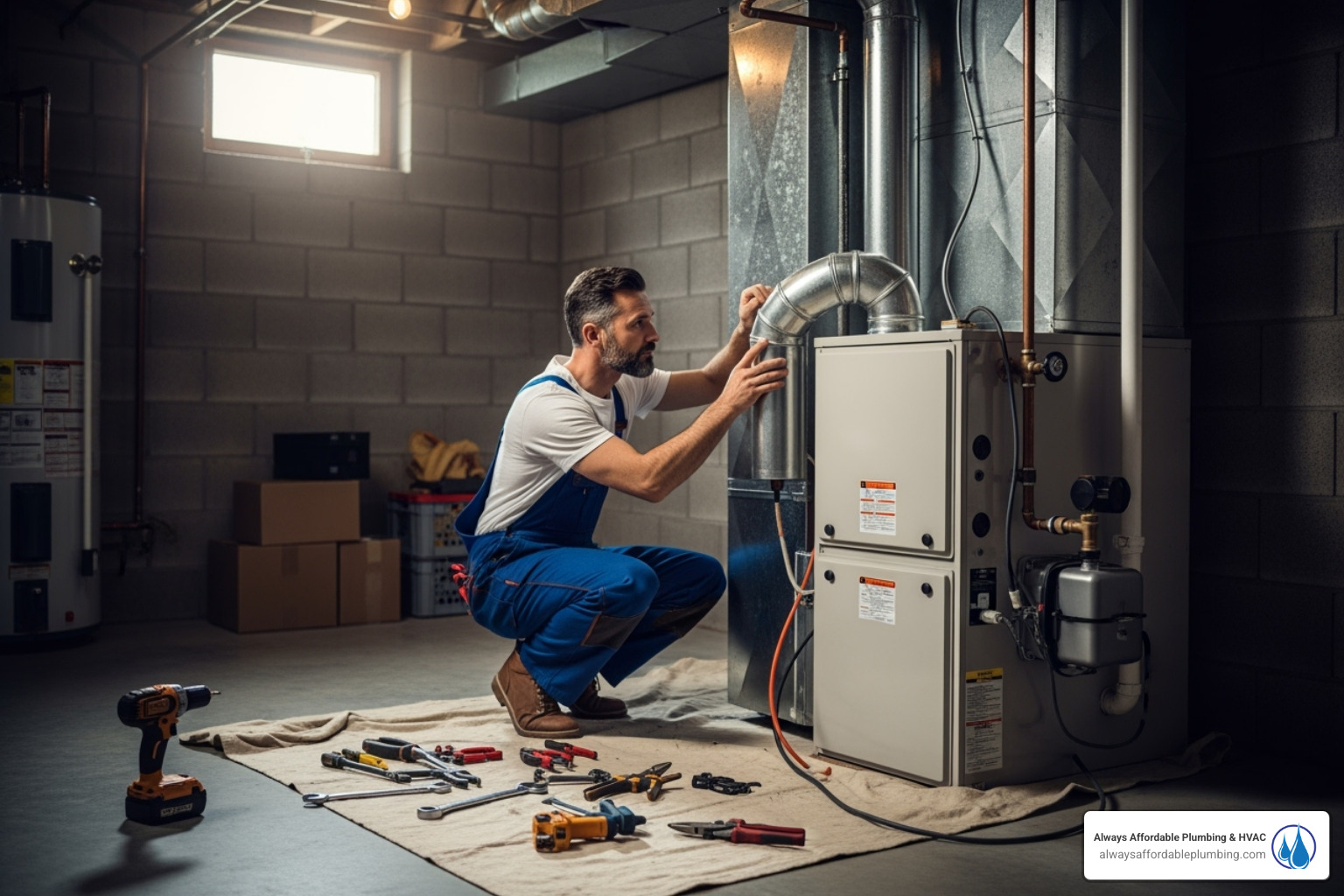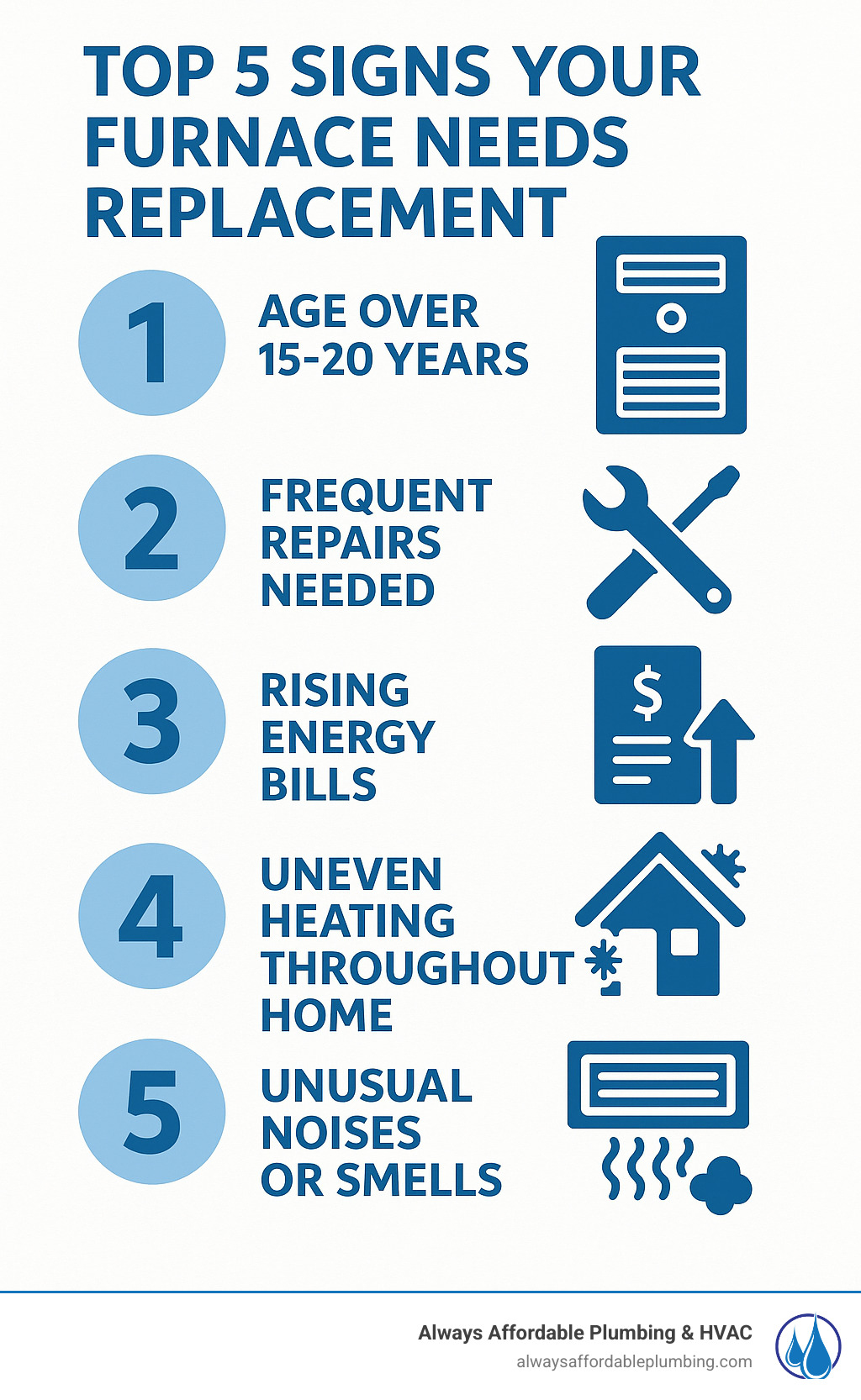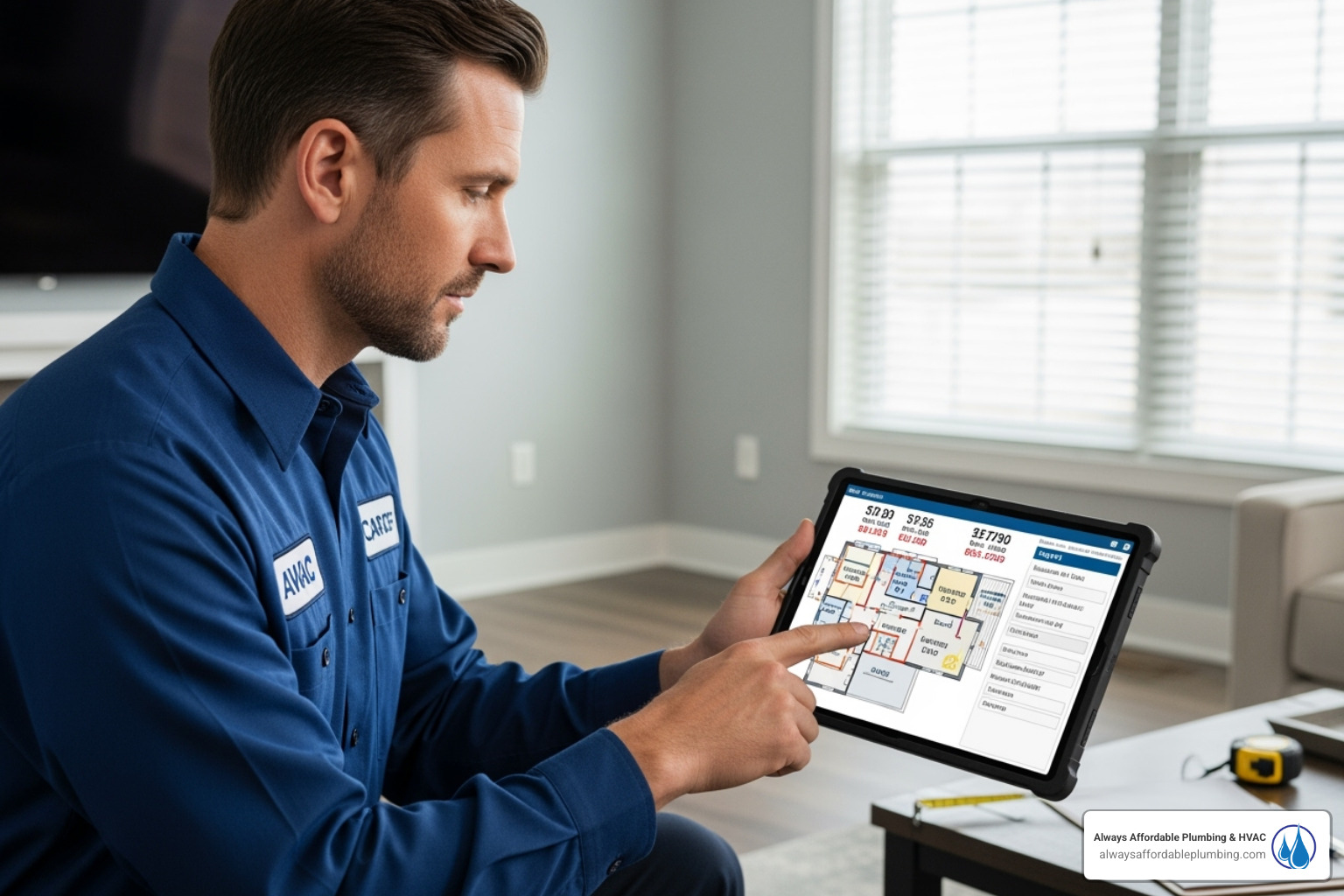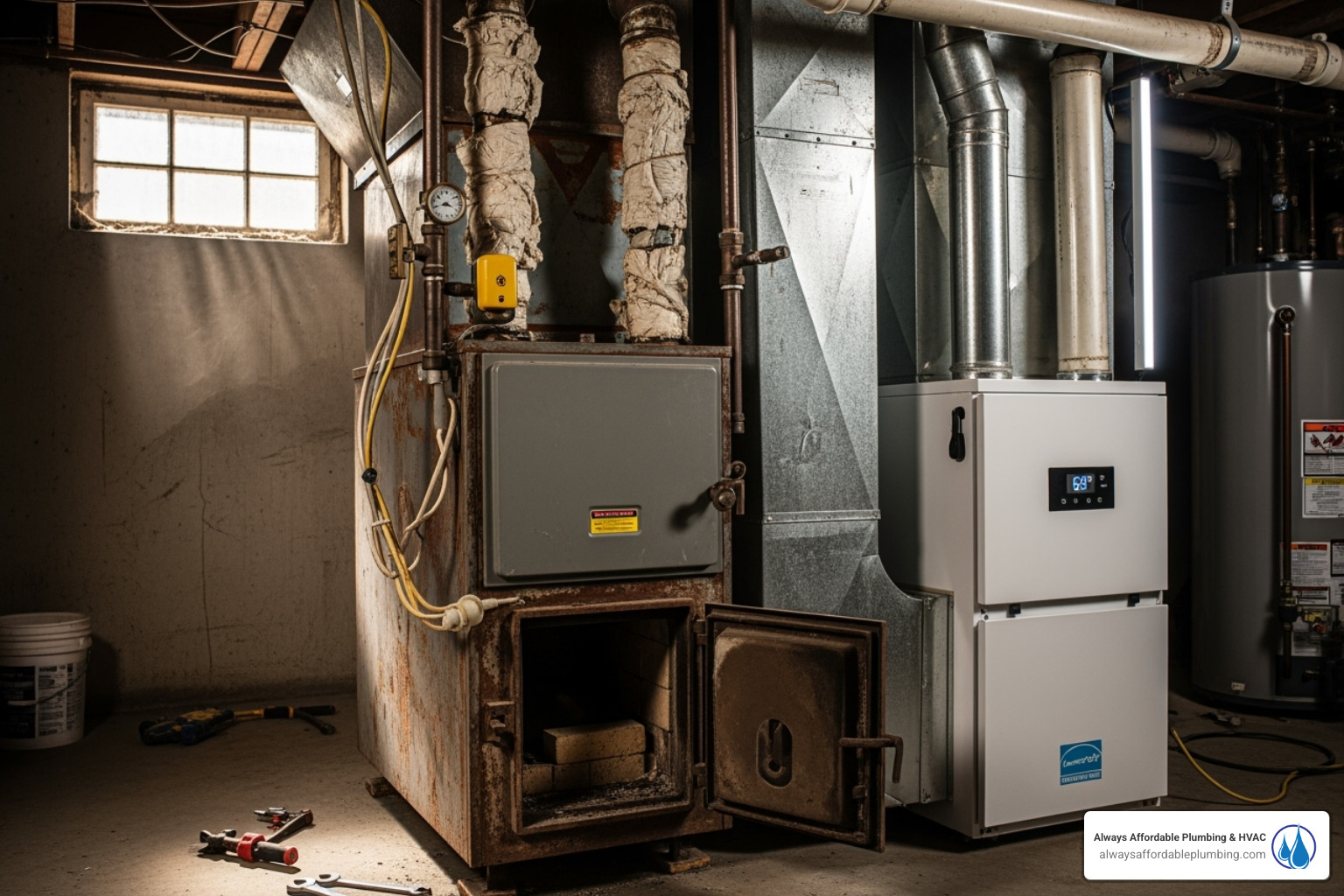
07 Oct Your Guide to Getting the Best Furnace Replacement Quote
Why Getting the Right Furnace Quote Matters for Your Home
Furnace replacement quotes can vary dramatically, often leaving homeowners confused. Understanding what goes into a quality quote helps you make the best decision for your home’s comfort and budget.
Key factors that affect furnace replacement quotes:
- Furnace size and capacity – Proper sizing based on your home’s square footage and heating needs
- Energy efficiency rating (AFUE) – Higher efficiency models cost more upfront but save money long-term
- Fuel type – Gas, electric, or oil furnaces have different equipment and installation costs
- Installation complexity – Ductwork modifications, permits, and accessibility affect labor costs
- Brand and warranty – Quality equipment typically comes with better warranties and longer lifespans
Most furnaces last 15-20 years. If your system is approaching this age or needs frequent repairs, replacement often makes more financial sense than continued fixes.
Replacing your furnace is a major investment in your home’s comfort. A quality installation can improve indoor air quality, reduce energy bills, and provide reliable heating for decades.
Getting multiple quotes from licensed contractors helps you compare similar equipment and services. Look for detailed breakdowns of equipment, labor, permits, and warranties, not just a bottom-line number.
Quick Furnace replacement quotes definitions:
Key Factors That Influence Furnace Replacement Quotes
Getting furnace replacement quotes can be confusing. Several important factors determine your final investment, and understanding them will help you make the smartest choice for your home.
The most crucial factor is getting the furnace size right. This isn’t about picking the biggest unit, but finding the perfect match for your home. A furnace that’s too large will constantly turn on and off, wasting energy and wearing out faster. One that’s too small will run constantly but never quite keep you comfortable.
A proper Manual J load calculation is essential. This industry-standard process from the Air Conditioning Contractors of America (ACCA) takes the guesswork out of sizing. A contractor considers your home’s square footage, insulation, window efficiency, ceiling height, and local climate to determine the required BTUs.
The energy efficiency rating (AFUE) of your chosen furnace also plays a major role in your quote. Think of AFUE as a report card—it tells you what percentage of fuel is converted into heat. A 90% AFUE furnace uses fuel much more efficiently than an 80% model, which means lower monthly bills but a higher upfront investment.
Your blower motor type is another key factor. Single-speed motors are the basic option, running at full blast. Variable-speed motors adjust their output for precise comfort and use less energy, much like a dimmer switch offers more control than a simple on/off switch.
Installation complexity can significantly impact your quote. A furnace in a cramped crawl space or a system requiring modifications to gas lines, electrical connections, or ventilation will affect labor time and material costs.
Don’t forget about local permit requirements. Every area has specific codes for furnace installations, and obtaining the proper permits ensures your new system meets all safety standards. We handle all the necessary paperwork for our HVAC Installation in Folsom, CA projects, making the process seamless for you.
Over 70% of HVAC systems are installed incorrectly. This makes choosing the right contractor just as important as the equipment. The day your furnace is installed is the most important day of its life.
Furnace Type and Fuel Source
The type of fuel your furnace uses has a huge impact on furnace replacement quotes. Your options depend largely on what’s available in your area, and each comes with its own advantages.
Gas furnaces are the most popular choice where natural gas is available. They heat up quickly, provide consistent warmth, and natural gas is often an affordable fuel option. If you already have a gas line, sticking with gas usually makes the most sense.
Electric furnaces work well in areas without natural gas access. They’re simpler and safer since there’s no combustion, but monthly bills depend on local electricity rates. In some regions, electric heat is affordable, while in others it costs more than gas.
Oil furnaces are common in rural areas without natural gas pipelines. These systems require an on-site oil storage tank, and heating costs fluctuate with oil prices. They can be very effective but typically require more maintenance than gas or electric systems.
Your local utility costs and fuel availability will largely determine the most financial sense for your situation.
Ductwork and Ventilation
Think of your furnace as the heart and your ductwork as the circulatory system. Even the most efficient furnace can’t work properly if your ducts are leaky, blocked, or poorly designed.
During our assessment, we’ll examine your existing ductwork condition. Old ducts often develop leaks, allowing heated air to escape into walls or attics. Poorly sized ducts can create airflow problems that make your new furnace work harder than necessary.
Sometimes existing ductwork needs modifications to work optimally with a new furnace. This might involve resizing sections, adding new return air ducts, or rerouting for better airflow. While these modifications add to your initial investment, they’re essential for getting the full benefit of your new system.
Proper airflow ensures even temperatures and helps your furnace operate efficiently. Sealing leaks in your ductwork can dramatically improve your system’s performance and lower your energy bills.
Brand and Warranty
When comparing furnace replacement quotes, don’t overlook equipment quality and warranty coverage. Reputable brands typically offer better performance, reliability, and longer lifespans, though they might require a higher initial investment.
Manufacturer warranties vary significantly. Some cover parts for 10 years or more, while others offer shorter coverage. A strong warranty shows the manufacturer’s confidence in their product and protects you from unexpected repair costs.
The labor warranty your contractor provides is equally important. It covers the installation work, ensuring any related problems are fixed at no charge. We stand behind our installations with comprehensive labor warranties.
Parts availability is another practical consideration. Popular, well-established brands typically have better parts availability, which means faster repairs if you ever need service. This becomes very valuable if you need a repair on a cold winter night.
Repair vs. Replace: When to Seek a Replacement
Deciding between repairing your current furnace or investing in a replacement can feel overwhelming. It’s a choice between immediate expenses and long-term comfort and savings, but clear indicators can guide your decision.
The age of your furnace is probably the most telling factor. Most furnaces have a lifespan of 15-20 years, and if yours is creeping into this range (or beyond), it’s time to seriously consider replacement. Think of it like an older car – you can keep fixing things as they break, but at some point, you’re just throwing good money after bad.
Another red flag is when your furnace starts demanding attention more frequently. If you’re calling for repairs multiple times a year, that’s your system’s way of telling you it’s tired. Similarly, if you’ve noticed your energy bills climbing despite using your heating the same way, your furnace is likely losing its efficiency battle. It’s working harder to produce the same warmth, which means it’s burning through more fuel.
Declining performance is another clear signal. Maybe some rooms never quite get warm enough, or you find yourself constantly fiddling with the thermostat. When your furnace can’t maintain consistent comfort throughout your home, it’s struggling to do its primary job. For more detailed insights on recognizing these warning signs, check out our guide on When to Consider Heater Replacement.
The 50% Rule
Here’s a helpful guideline that many HVAC professionals swear by: the 50% Rule. Simply put, if a major repair would cost 50% or more of what a new furnace would cost, replacement is almost always the smarter financial move.
You’d be investing significant money into an aging system that will likely face more problems. It’s like a costly repair on a high-mileage car; another failure could be just around the corner.
Choosing replacement over expensive repairs gives you a long-term investment that eliminates the stress of wondering when the next breakdown will happen. Plus, you’ll start enjoying the benefits of modern efficiency and reliability immediately, rather than hoping your patched-up system holds together through another winter.
Benefits of a New Furnace
When you invest in a new furnace, you’re not just buying a heating system – you’re upgrading your entire home comfort experience. The improved energy efficiency alone can be a game-changer. Modern furnaces, especially high-efficiency models, convert much more fuel into actual heat compared to older units. This efficiency translates directly into lower utility bills every month, which adds up to significant savings over time.
But the benefits go far beyond just saving money. A new furnace delivers improved comfort with more consistent, even heating throughout your home. No more bundling up in that one chilly bedroom or cranking the thermostat higher just to get decent heat in the living room.
Better indoor air quality is another fantastic advantage, especially when you pair your new system with modern filtration options. This can make a real difference for family members with allergies or breathing sensitivities. And let’s not forget about new technology – today’s furnaces operate much more quietly and often work seamlessly with smart thermostats, giving you greater control and convenience.
The peace of mind that comes with a reliable, efficient system is honestly priceless. No more holding your breath every time you hear an unusual noise or worrying about whether your furnace will make it through the next cold snap. For a deeper exploration of why replacement often makes the most sense, take a look at our article on Why HVAC Replacement is Necessary.
How to Compare Furnace Replacement Quotes Like a Pro
Getting furnace replacement quotes doesn’t have to be a puzzle. Like shopping for a car, a careful approach is needed, and we’re here to help you make this important decision with confidence.
The golden rule is simple: get at least three quotes. This gives you a solid foundation for comparison and helps you spot any outliers – whether surprisingly high or suspiciously low. But here’s where many homeowners stumble: they focus only on the bottom line number. That’s like comparing apples to oranges.
What you really want is an apples-to-apples comparison. Each quote should specify the same furnace type, efficiency rating, and similar features. If one quote seems dramatically lower than the others, dig deeper. Sometimes contractors cut corners on equipment quality, skip proper sizing calculations, or leave out essential installation steps. A deal that seems too good to be true usually is.
Quality quotes are transparent. They break down exactly where your investment is going – equipment, labor, permits, and additional services. This transparency isn’t just nice to have; it’s essential for making an informed decision. When everything is laid out clearly, you can see the value you’re getting and avoid unpleasant surprises later.
Here are the essential questions every homeowner should ask when comparing furnace replacement quotes:
- What specific furnace model and brand are you proposing, and what are its exact specifications?
- Will you perform a Manual J Load Calculation to properly size my furnace?
- What’s included in the installation process beyond just the furnace itself?
- Are all labor costs and warranties clearly outlined?
- Who handles permits, and are they included in the quote?
- What manufacturer warranties come with this equipment?
- Can you provide recent customer references?
Choosing a Qualified Contractor
The contractor you choose matters as much as the furnace itself. Even the best furnace will underperform if installed poorly.
Start with the basics: licensing and insurance. Any contractor working on your home should be fully licensed in your area and carry proper insurance. This protects you if something goes wrong during installation. Don’t be shy about asking to see these credentials – reputable contractors are happy to share them.
Local reputation speaks volumes. Check online reviews on Google and the Better Business Bureau. What are neighbors saying about their experience? Look for patterns in the feedback. Does this contractor consistently show up on time? Do they clean up after themselves? Do they stand behind their work when issues arise?
A contractor with deep community roots, like Always Affordable Plumbing & HVAC in the Sacramento area, has built their reputation over time. They can’t afford to cut corners because their reputation depends on satisfied customers who might recommend them to friends and family. This local accountability is invaluable when you need reliable Expert Heating Services.
Understanding the Details in Your Furnace Replacement Quotes
A valuable quote tells a story of what will happen in your home and what you’re getting for your investment. We believe in transparency because informed customers make the best decisions.
The equipment list should be specific. Look for exact model numbers, not just “high-efficiency gas furnace.” Knowing the precise model lets you research its features, efficiency rating, and customer reviews independently. This level of detail shows the contractor has done their homework and isn’t trying to hide anything.
Labor charges cover the skilled work that transforms a box of equipment into your home’s heating system. This includes professional installation, electrical connections, gas line work (if needed), and thorough system testing. Quality installation takes time and expertise – it’s not a corner you want anyone cutting.
Don’t overlook permit fees. Most areas require permits for furnace replacement to ensure safety and code compliance. A professional contractor includes these fees and handles the permit process, so you don’t have to steer city hall bureaucracy.
Debris removal might seem like a small detail, but your old furnace doesn’t just disappear. Make sure the quote includes proper disposal of your old equipment. Finally, confirm the project timeline. Knowing what to expect – from start to finish – helps you plan and reduces stress on installation day.
Additional System Upgrades
While you’re investing in a new furnace, it’s the perfect time to consider upgrades that can improve your entire home comfort experience. Think of it as renovating your kitchen – once you’re already making changes, it’s often more efficient to tackle related improvements at the same time.
Smart thermostats are incredibly popular for good reason. They learn your schedule, can be controlled from anywhere via your smartphone, and often optimize your heating patterns automatically. Many homeowners are amazed at how much more comfortable and efficient their homes become with intelligent temperature control.
For families dealing with dry winter air or allergy concerns, whole-home humidifiers and air purification systems can be game-changers. A humidifier prevents the dry, scratchy feeling that comes with heated air, while air purifiers remove dust, pollen, and other irritants from your home’s air supply.
Zoning systems offer the ultimate in personalized comfort. Instead of heating your entire home to the same temperature, you can control different areas independently. Heat the living areas during the day and the bedrooms at night, or keep unused rooms cooler to save energy. It’s like having multiple thermostats working together to create perfect comfort zones throughout your home.
These upgrades represent additional investments, but they can significantly improve your daily comfort, indoor air quality, and long-term energy savings. The key is understanding which options make sense for your family’s specific needs and lifestyle.
Frequently Asked Questions about Furnace Replacement
It’s natural to have questions when considering a furnace replacement, as it’s a significant investment in your home’s comfort and efficiency. Let’s address the most common concerns that arise when reviewing furnace replacement quotes.
What is AFUE and how does it affect my furnace choice?
AFUE stands for Annual Fuel Utilization Efficiency, and it’s one of the most important numbers you’ll see on any furnace specification sheet. Think of AFUE like your car’s gas mileage rating – it tells you how much of the fuel you’re paying for actually gets converted into heat for your home.
Here’s how it works: if your furnace has an 80% AFUE rating, that means 80% of the fuel gets turned into heat, while the remaining 20% goes up the chimney as waste. A 95% AFUE furnace converts 95% of the fuel into heat, wasting only 5%. The difference might seem small, but over the life of your furnace, it adds up to significant savings on your energy bills.
Since January 1, 2015, all new furnaces must meet a minimum AFUE of at least 80%. High-efficiency models typically start at 90% AFUE and can reach as high as 98%. While these high-efficiency units require a larger upfront investment, they often pay for themselves through lower monthly utility bills, especially in colder climates where your furnace runs frequently.
The key is balancing the upfront investment with long-term savings. If you’re planning to stay in your home for many years, that higher efficiency rating becomes increasingly valuable over time.
How do single-stage, two-stage, and variable-speed furnaces differ?
Understanding these different furnace types is crucial when comparing quotes, as they significantly affect both your comfort and energy efficiency. Each type operates differently to meet your home’s heating needs.
Single-stage furnaces are the most straightforward – they’re either on at full blast or completely off. When your thermostat calls for heat, the furnace fires up at 100% capacity until the temperature is reached, then shuts off completely. It’s like having a light switch with only two positions. While these are typically the most affordable option upfront, they can create noticeable temperature swings and may not be the most efficient choice.
Two-stage furnaces offer more flexibility with both a high and low heat setting. Most of the time, they operate on the lower setting (usually 60-75% capacity), which provides gentler, more consistent heating. The high stage only kicks in during particularly cold weather when you need that extra heating power. This approach reduces those uncomfortable temperature swings and typically improves efficiency.
Variable-speed furnaces are the premium option, offering precise control over both heat output and fan speed. Instead of just two settings, they can modulate anywhere from about 35% to 100% capacity, constantly adjusting to match your home’s exact heating needs. This results in incredibly consistent temperatures, quieter operation, and the highest efficiency ratings.
The impact on comfort and efficiency varies significantly between these types. Variable-speed units provide the most consistent comfort, while single-stage units may leave you with hot and cold cycles. Matching the furnace type to your climate and needs is essential – homes in milder climates might do fine with single-stage, while those in harsh winter areas often benefit from the precision of variable-speed systems.
How long does a furnace installation take?
Most homeowners are relieved to learn that a typical furnace installation can usually be completed in a single day. Our experienced technicians work efficiently to get your new system running as quickly as possible, minimizing any time you’re without heat.
Before installation day, there are a few preparation steps that help everything go smoothly. Clear the area around your existing furnace so our team has easy access. If you have valuable items nearby, consider moving them to a safe location. Make sure there’s a clear path from outside to your furnace location – this helps when we’re bringing in the new equipment and removing the old unit.
On installation day, here’s what to expect: Our team arrives on time with all the necessary equipment and materials. We’ll carefully disconnect and remove your old furnace, taking care to protect your home’s surfaces and belongings. Then comes the installation of your new system, including connecting it to your existing ductwork, gas lines (if applicable), and electrical system.
The most critical part is system testing. We thoroughly test every component to ensure your new furnace operates safely and efficiently. This includes checking gas connections for leaks, verifying proper airflow, and making sure all safety systems function correctly. We’ll also program your thermostat and walk you through how to operate your new system.
For a detailed breakdown of each step, you can read more about The Heater Installation Process. The day your furnace is installed truly is the most important day of its life – proper installation ensures years of reliable, efficient operation.
Conclusion: Get Your Reliable Furnace Quote Today
Making sense of furnace replacement quotes is about understanding your investment in home comfort and efficiency. This guide covered the essential elements that shape your investment, from furnace size and efficiency to installation complexity and the importance of working with qualified professionals.
The decision between repair and replacement becomes clearer when you consider factors like your furnace’s age, the frequency of breakdowns, and rising energy bills. Remember the 50% rule – if a major repair costs half of what a new furnace would, replacement is usually the smarter long-term choice.
When comparing quotes, focus on getting detailed breakdowns rather than just bottom-line numbers. Look for itemized equipment lists, labor warranties, and comprehensive installation services that include permits and debris removal. The right contractor will provide transparency at every step, ensuring you understand exactly what you’re getting.
Quality installation makes all the difference, as even the best furnace will underperform if installed incorrectly. Choosing a trusted partner is critical. We provide transparent, comprehensive quotes because your comfort and peace of mind are our top priorities.
Your home deserves reliable heating that keeps your family comfortable for years to come. We’re committed to helping you make the best decision for your specific needs, whether that’s a high-efficiency gas furnace, smart thermostat integration, or comprehensive ductwork improvements.
Ready to take the next step? For a comprehensive and transparent quote from a team dedicated to your comfort and satisfaction, explore our furnace installation services in Folsom, CA. We’re here to answer your questions and help you find the perfect heating solution for your home.






